�
Kenneth Ireland
(deceased)
J.H. Ewing
Editorial
Board
Department of
M athematics
Indiana University
Bloomington, IN 47405
USA
With 1 illustration.
of Mathematics
Michael Rosen
Department
Brown University
Providence,
USA
RI02912
F. W. Gehring
Department
of
P.R. Halmos
Department
of
Mathematics
Mathematics
of Michigan
University
Ann Arbor, MI 48109
USA
Santa Clara University
Santa Clara, CA 95053
USA
Mathematics
Subject Classification:
11-01, 11-02
Library of Congress Cataloging-in-Publication
Ireland, Kenneth F.
A classical
to modem number theory / Kenneth
introduction
Data
Ireland, Michael Rosen.-2nd ed.
p. cm.-(Graduate
texts in mathematics;
Includes bibliographical
references
1. Number theory. I. Rosen, Michael I. II. Title. III. Series.
84)
and index.
QA241.I667 1990
512.7-dc20
90-9848
"A Classical
"Elements of Number Theory"
Introduction
to Modem Number Theory" is a revised and expanded version of
published
in 1972 by Bogden and Quigley, Inc., Publishers.
© 1972, 1982, 1990 Springer-Verlag
New York, Inc.
Use in connection
(Springer-Verlag
or copied in whole or in part without the
analysis.
adaptation,
This work may not be translated
of the publisher
All rights reserved.
written permission
New York, NY 10010, USA), except for brief excerpts in connection with reviews or
scholarly
electronic
known or hereafter developed
The use of general descriptive
even if the fonner are not especially
as understood
freely by anyone.
is forbidden.
names, trade names, trademarks,
is not to be taken as a sign that such names,
be used
computer software, or by similar or dissimilar
by the Trade Marks and Merchandise
with any fonn of information
New York, Inc., 175 Fifth Avenue,
Marks Act, may accordingly
methodology now
identified,
storage and retrieval,
etc., in this pubJication,
ISBN 0-387-97329-X Springer-Verlag
ISBN 3-540-97329-X
New York Berlin Heidelberg
Berlin Heidelberg
Springer-Verlag
New York
�
Preface to the Second Edition
It is now 10 years since the first edition of this book appeared in 1980. The
decade has seen tremendous advances take place in mathe
intervening
matics generally,
able to treat some of these advances, and with the addition of two new
we are able to cover some portion of this new material.
chapters,
As examples of important new work that we have not included, we
and in number theory in particular.
It would seem desir
mention the following
two results:
(2) Let PI, P2, and P3 be three distinct
(1) The first case of Fermat's last theorem is true for infinitely
many
many primes p, the
prime exponents p. This means that, for infinitely
equation xP + yP = zP has no solutions
with p r
in nonzero integers
xyz. This was proved by L.M. Adelman and D.R. Heath-Brown and
by E. Fouvry. An overview of the proof is given by
independently
Heath-Brown in the Mathematical Intelligencer (Vol. 7, No.6, 1985).
primes. Then at least one of them is
many primes q. R-ecall that E. Artin
a primitive
conjectured that, if a E Z. is not 0, 1, -1, or a square, then there are
q. The
infinitely
theorem we have stated was proved in a weaker form by R. Gupta and
M.R. Murty, and then strengthened
by the combined efforts of R.
Gupta, M.R. Murty, V.K. Murty, and D.R. Heath-Brown.
tion of this result,
M.R. Murty in the Mathematical Intelligencer (Vol. 10, No.4, 1988).
An exposi
as well as an analogue on elliptic curves,
is given by
many primes q such that a is a primitive root modulo
root for infinitely
The new material that we have added falls
within the frame
geometry. In Chapter 19 we give a complete proof of
principally
work of arithmetic
L.J. Mordell's
fundamental
theorem, which asserts that the group of ra-
v
�
VI
Preface
to the Second Edition
curve, defined over the rational
numbers, is
In keeping with the spirit of the book, the proof (due in
tional points on an elliptic
finitely generated.
essence to A. Weill is elementary.
or any other advanced machinery.
and a weak form of the Dirichlet unit theorem;
the text.
It makes no use of cohomology groups
It does use finiteness
of class number
both results are proved in
The second new chapter, Chapter 20, is an overview of G. Faltings's
curves, especially
and recent progress on the arithmetic
of
the work of B. Gross, V.A. Kolyvagin, K.
to
proof of the Mordell conjecture
elliptic
Rubin, and D. Zagier. Some of this work has surprising applications
other areas of number theory. We discuss one application
theorem, due to G. Frey, J.P. Serre, and K. Ribet. Another important
application
class numbers of imaginary quadratic
number fields. This comes about by
combining the work of B. Gross and D. Zagier with a result of D. Gold
feld. This chapter contains few proofs. Its main purpose is to give an
informative
background necessary to a better understanding
important new developments.
is the solution of an old problem due to K.F. Gauss about
survey in the hope that the reader will be inspired
and appreciation
to Fermat's last
to learn the
of these
The rest of the book is essentially_
unchanged. An attempt has been
In an effort to keep confusion to a
made to correct errors and misprints.
minimum, we have not changed the bibliography
New references
found at the end of those chapters.
and others for submitting
thank Linda Guthrie for typing portions of the final chapters.
Chapters 19 and 20, will be
for the two new chapters,
from the first edition.
a list of misprints
We would like
at the end of the book.
to thank TofU Nakahara
Also, we
We have both been very pleased with the warm reception
that the first
It is our hope that the new edition will
edition of this book received.
continue to entice readers to delve deeper into the mysteries of this an
cient, beautiful,
February 1990
and still vital subject.
Kenneth Ireland
Michael Rosen
Second Corrected
Addendum to Second Edition,
The.second
tions and the addition of a few clarifyin
g comments.
K. Conrad, M. Jastrzebski, F. Lemmermeyer
trouble to send us detail
printing
of mispr
of the second edition is unchanged
Printing
except
ed lists
ints.
and others who took the
I would like to thank
for correc
November
1992
Michael Rosen
�
Preface
book the primary audience
of
undergrad
ch backgro
of upper level
and greatly
expanded version of our book Elements
published in 1972. As with the first
This book is a revised
N umber Theory
uate mathematics majors and
we envisage consists
graduate students. We have assumed some familiarity with the material in a
standard undergraduate course in abstract
portion of
Chapters
small amount of supplemen
knowledge of Galois theory, and in Chapters 1 6 and 18
the theory
1-11 can be read even without su
und with the aid of a
assume some
tary reading. The later
algebra. A large
Number theory is an ancient
of complex variables
is necessary.
subject and
, make a very limited selection from the
array of possible topics. Our focus is on topics which point in the
geometry.
we have found it possible to exposit some
material without requiring very much in the way of technical
is classical in the sense that is was dis
but it is also
going on at the present
ductory book must, of necessity
fascinating
direction of algebraic
careful selection of subject matter
rather
background. Most of this material
covered during the
because
time.
nineteenth
y related to important
number theory and arithmetic
century and earlier,
an acquaintance with
algebraic
By a
it is intimatel
chapters
advanced
research
modern
its content is vast
. Any intro
In Chapters
1-5 we discuss prime numbers,
unique
factorizati
and the law of quadratic reciprocity.
und. Nevertheless
it is remarkable how a
metic functions, congruences,
is demanded in the way of backgro
modicum
subject.
to a natural questio
Z/nZ?
For example,
of group and ring theory introduces unexpected order into the
many scattered results
n : What is the structur
turn out to be parts
e of the group of
the ring
units in
of the answer
on, arith
Very little
VB
�
Vllt
Preface
law, one of the major
reciprocity,
by formulating
Artin reciprocity
of algebraic number theory. We travel along the road beyond
Reciprocity laws constitute a major theme in the later chapters. The law
beautiful in itself, is the first of a series of reciprocity
of quadratic
laws which lead ultimately to the
a�hievements
quadratic reciprocity
biquadratic reciprocity. In preparation for this many of the techniques
algebra
integers,
investigation
material
the more advanced
reciprocity
cubic and
of
numbers and algebraic
etc. Another important
tool in this
of Gauss and Jacobi sums. This
we formulate and prove
the Eisenstein
of primes,
theory
generalization of these results,
6-9. Later in the book
and proving the laws of
are introduced; algebraic
(and in others!) is the
is covered in Chapters
finite fields, splitting
ic number theory
partial
law.
A second major theme is that of diophant
ine equations, at first over finite
over the ra
numbers. The discussion of polynomial
over finite fields is begun in Chapters 8 and 10 and culminates in
tional
of a portion of the paper " Number of solutions
development
11 with an exposition
fields" by A. Weil. This paper,
recent
In Chapters
fields and later
equations
Chapter
of equations over finite
been very influential in the
and number theory.
over the rational
sums of squares to Fermat's
developed earlier
we are able
point of view. Chapter 18 is about the arithmetic
fers from the
in that it is primarily
definitions
centrating
something of the beauty of
is being done and many mysteries remain.
and statements of results
on some important special
17 and 18 we cons
17 covers
numbers. Chapter
earlier
chapters
of elliptic curves. It dif
an overview
with many
but few proofs. Nevertheless,
by con
to the reader
cases
we hope to convey
the accomplishments in this area where much work
published in 1948, has
of both algebraic
ider diophantine
from
many standard topics
geometry
equations
Last Theorem. However,
to treat a number of these topics
because of material
from a novel
The third, and final,
major theme is that of zeta functions.
zeta function associated to varieties
11 we
In Chapter
defined over finite
16 we discuss the Riemann zeta function and the Dir
ichlet
discuss the congruence
fields. In Chapter
L-functions. In Chapter 18 we discuss
algebrai
ned over the rational
Zeta functions
single function
analysis
compress
and make possibl
to number theory.
c curve defi
the zeta function
associat
ed to an
numbers and Hecke L-functions.
a large amount of arithmetic
information into a
e the application
of the powerful methods of
l'hroughout the book we place considerab
le emphasis on
In the notes at the end of each chapter we give a brief
the history of
to the literature. The
historical
bibliography is extensi ve
our subject.
sketch and provide
containing
provide the reader with a wealth
references
many items both classical and modern. Our aim
has been to
of material for further
study.
There are many exercises, some routine, some challenging. Some of the
by providing a step by step guide through the
supplement the text
exercises
proofs of important
from results
been adapted
results.
In the later chapters
which have appeared
a number of exercises
in the recent
literatur
have
e. We
�
Preface
IX
hope that working through the exercises
as instruction.
will be a source
of enjoyment as well
In the writing
of this book we
have been helped immensely by the interest
nce of many matherr�atical friends and acquaintances.
We thank
ar we would like to thank Henry Pohlmann who insisted
conclusion, David Goss for allowing
16, and Oisin McGuiness
logical
themes to their
some of his work into Chapter
assistance
patience and expertise
in the prepara
h, Janice Phillips,
tion of Chapter
cially
large portions
in typing
and espe
1 8. We would
Carol Ferreira,
to express his
support during his sabbati
of the manuscript.
gratitude to the Vaughn
cal year in
wishes
Fund for financial
In particul
and assista
them all.
we follow certain
us to incorporate
for his invaluable
like to thank Dale Cavanaug
for their
Finally, the second author
Foundation
Berkeley, California (1979/80).
July 25, 1981
Kenneth
Ireland
Michael Rosen
�
�
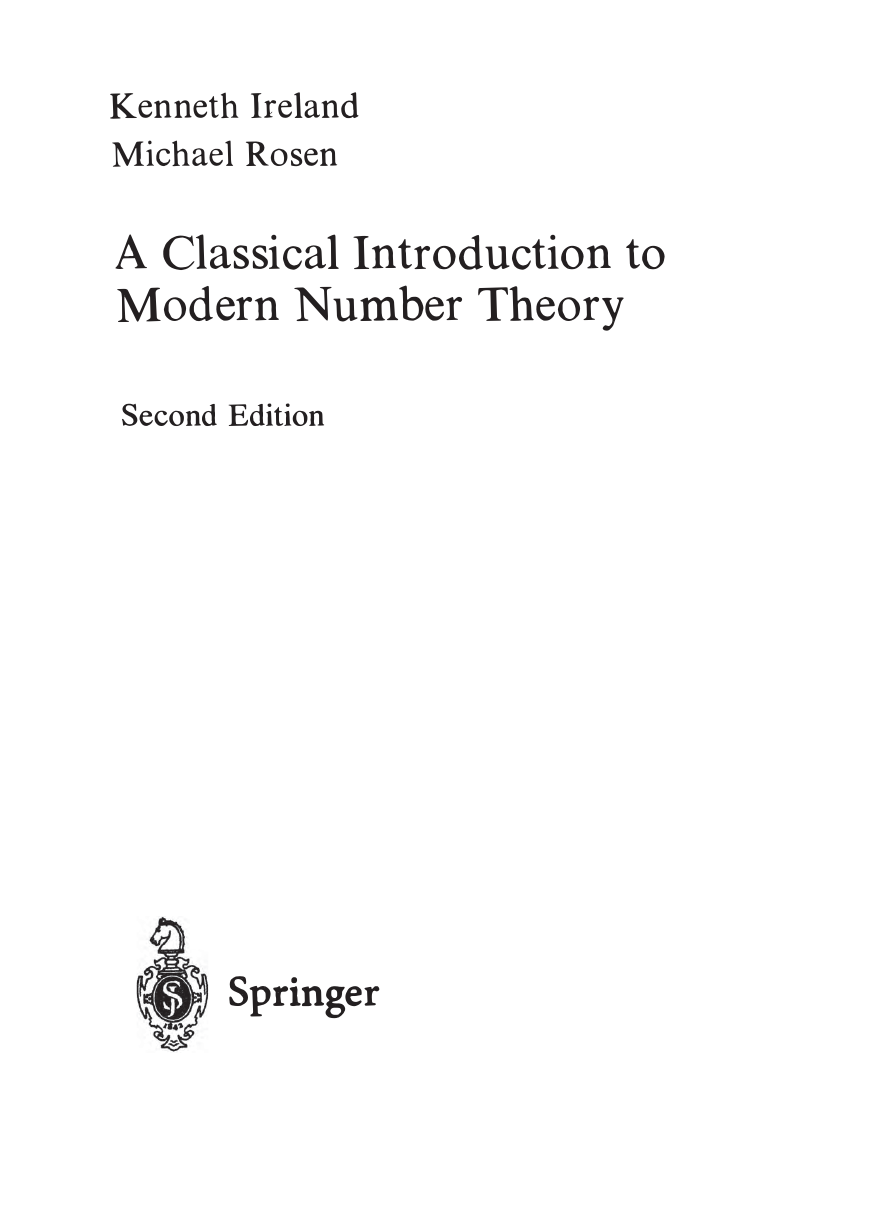

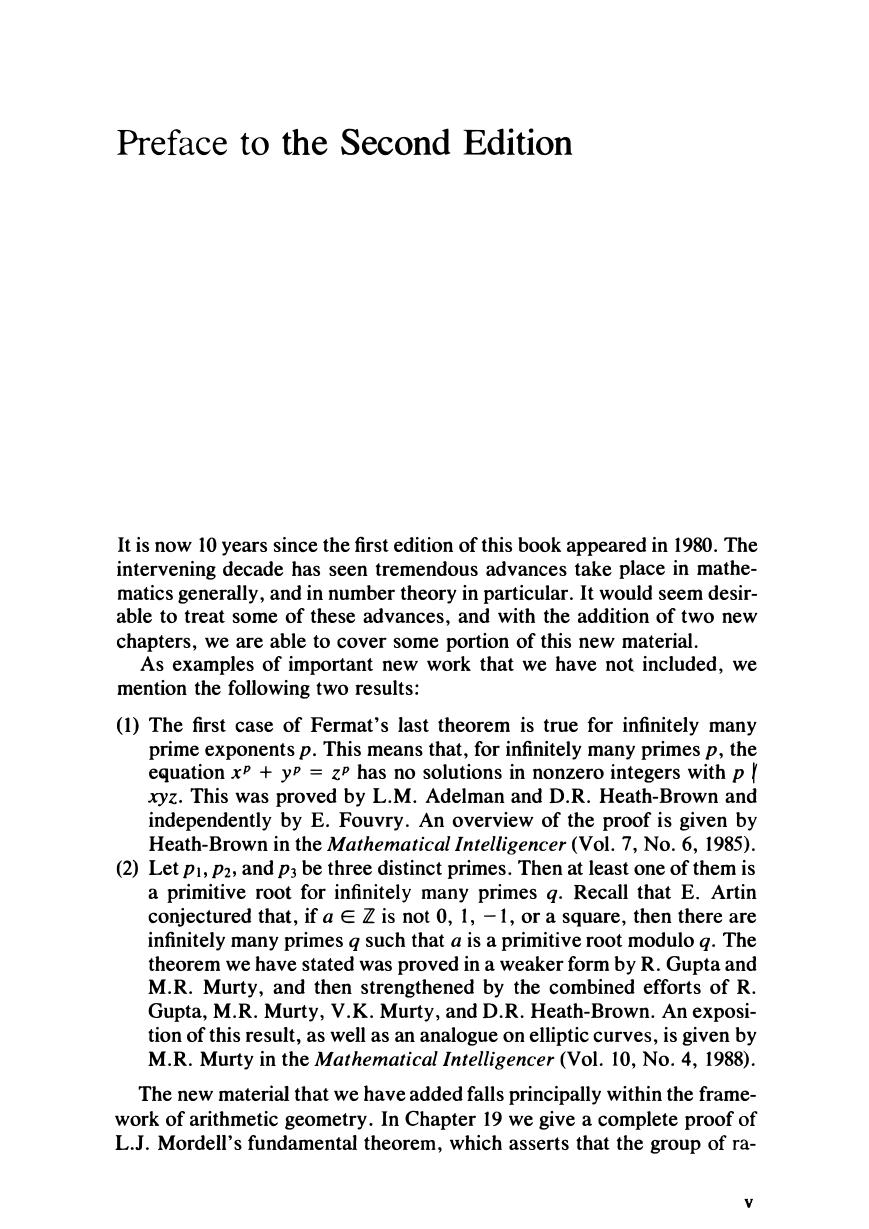
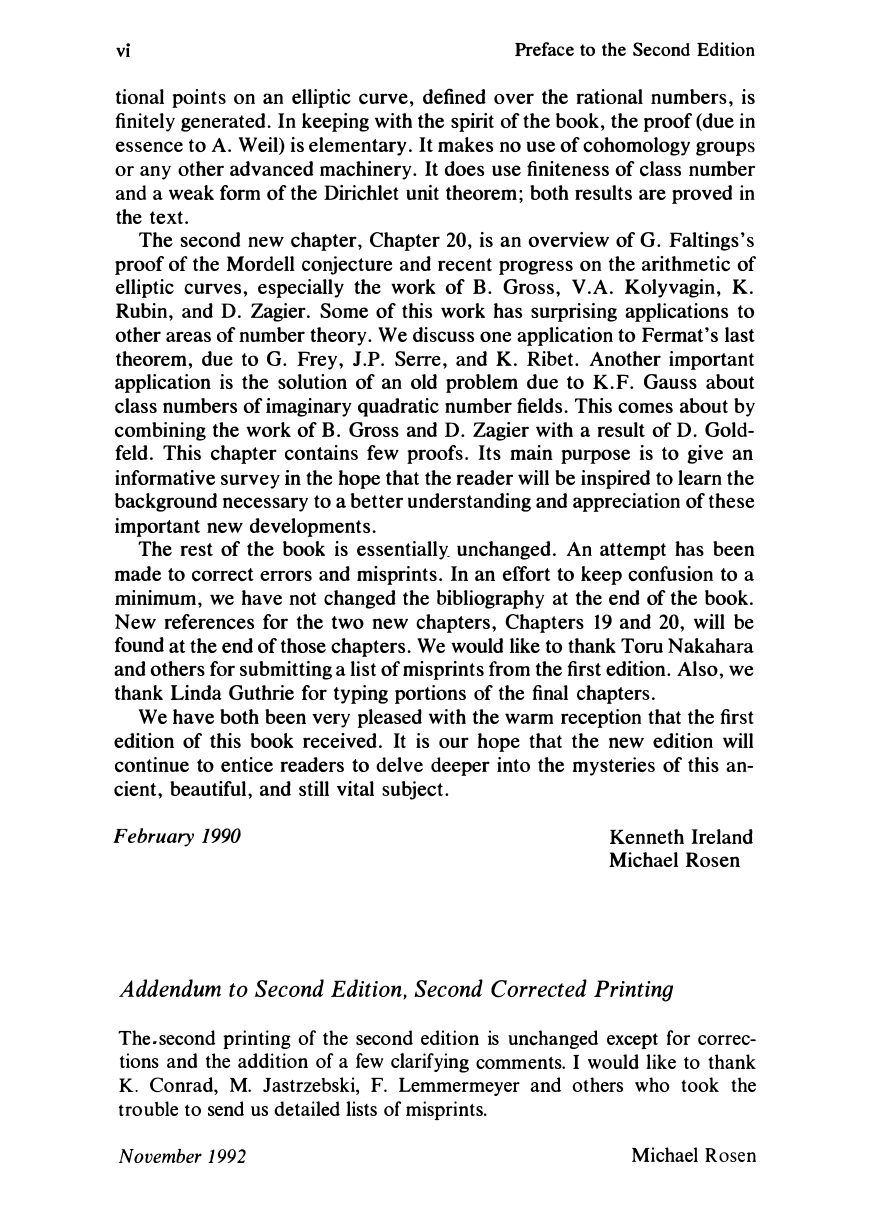

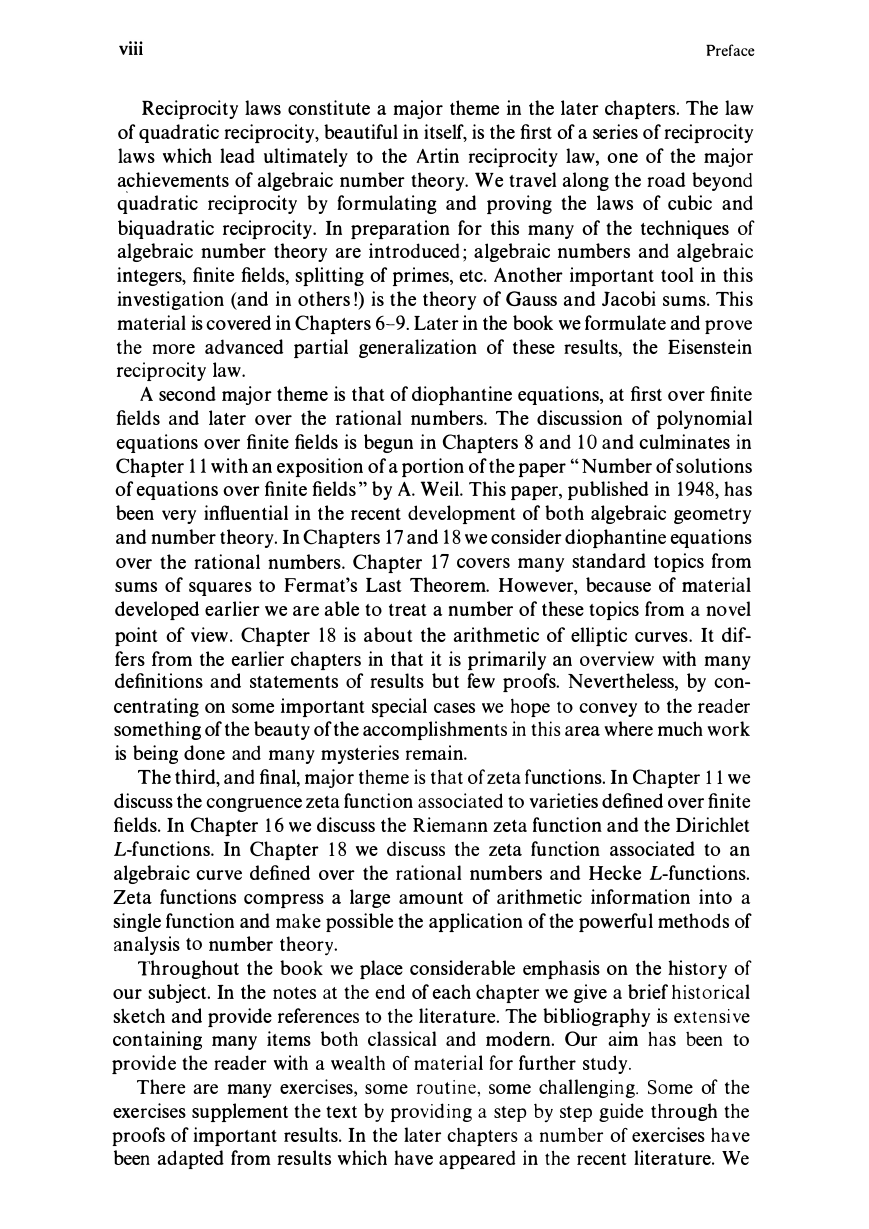
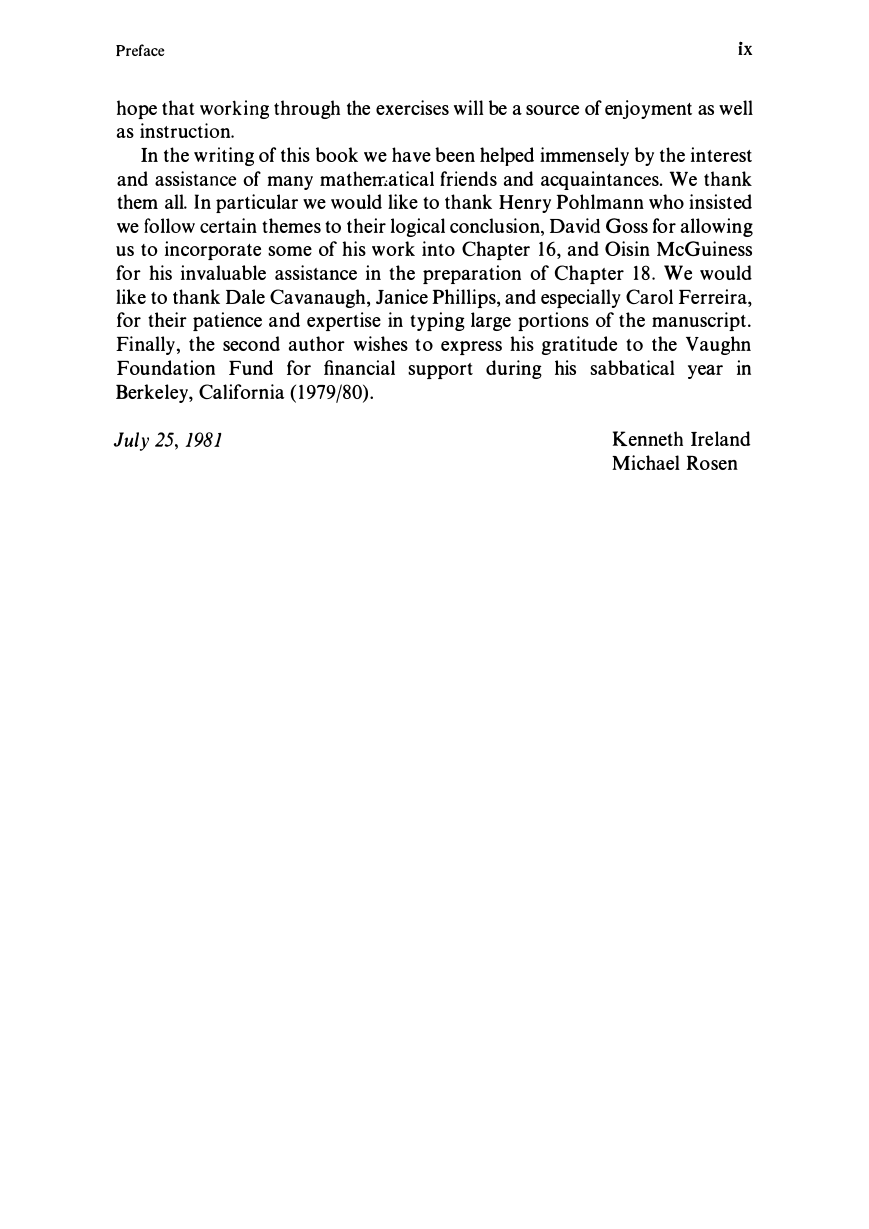









 2023年江西萍乡中考道德与法治真题及答案.doc
2023年江西萍乡中考道德与法治真题及答案.doc 2012年重庆南川中考生物真题及答案.doc
2012年重庆南川中考生物真题及答案.doc 2013年江西师范大学地理学综合及文艺理论基础考研真题.doc
2013年江西师范大学地理学综合及文艺理论基础考研真题.doc 2020年四川甘孜小升初语文真题及答案I卷.doc
2020年四川甘孜小升初语文真题及答案I卷.doc 2020年注册岩土工程师专业基础考试真题及答案.doc
2020年注册岩土工程师专业基础考试真题及答案.doc 2023-2024学年福建省厦门市九年级上学期数学月考试题及答案.doc
2023-2024学年福建省厦门市九年级上学期数学月考试题及答案.doc 2021-2022学年辽宁省沈阳市大东区九年级上学期语文期末试题及答案.doc
2021-2022学年辽宁省沈阳市大东区九年级上学期语文期末试题及答案.doc 2022-2023学年北京东城区初三第一学期物理期末试卷及答案.doc
2022-2023学年北京东城区初三第一学期物理期末试卷及答案.doc 2018上半年江西教师资格初中地理学科知识与教学能力真题及答案.doc
2018上半年江西教师资格初中地理学科知识与教学能力真题及答案.doc 2012年河北国家公务员申论考试真题及答案-省级.doc
2012年河北国家公务员申论考试真题及答案-省级.doc 2020-2021学年江苏省扬州市江都区邵樊片九年级上学期数学第一次质量检测试题及答案.doc
2020-2021学年江苏省扬州市江都区邵樊片九年级上学期数学第一次质量检测试题及答案.doc 2022下半年黑龙江教师资格证中学综合素质真题及答案.doc
2022下半年黑龙江教师资格证中学综合素质真题及答案.doc